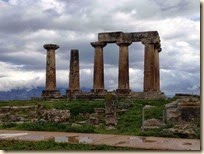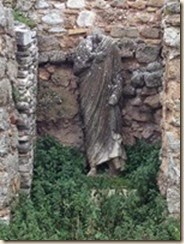Today dawns cold and cloudy. We pull into Piraeus a little early, but under dark and threatening skies. Oh well, another umbrella day. We do our normal morning thing, then head out to find the Hertz office near the port. We’re a little concerned, because while they have accepted our reservation, the description of the office on the website says it is seasonal – April through October. Hmmmm…
Turns out the office is really close, and really open! Yay! We want to go to Ancient Korinthos today, to explore the ruins, have lunch in old time and see the canal. If there was no car, we were figuring this would be a “sea” day for us and we’d just go back to the ship. Nope – we’re exploring!
The rental agent is the best – he is so nice and helpful. Prints us out a color map of Piraeus and tells us how to get to Korinthos – an easier way he says – plus explains how to get to the bridge at the canal. Nice. We’re finally on the road (Ed says he’s bought cars in less time than we rented this one!), and head out around the harbor (always keep the water on your left and “ignore” the first sign to Korinthos). Knowing Alice like we do, we turn her off and follow the agent’s instructions. Not the most bright idea. He’s sweet, but his directions are not right and we end up lost for about 10 minutes in the West end of Piraeus. Even though we can’t find the ancient ruins site on Alice, we turn her back on and head toward Modern Korinthos – and at least she gets us on the highway and on our way.
Takes about an hour of highway driving until we see signs for Ancient Korinthos. Once we’re on the right road, it’s easy. We find the museum and archeological site with only a couple of mishaps (sigh – we will NEVER d0 the Amazing Race!!) and are safely inside by 10am.
It’s really quite amazing – all these ancient ruins. This site reached its peak in the 7th C BC. Simply astonishing what has been excavated and saved. In the 5th C BC, Korinthos was one of the 3 major powers in Greece. It was totally destroyed in 146 BC by the Romans and then resettled again in 44 BC by Julius Caesar. The city grew around the Temple of Apollo – which you will see we were quite obsessed with. The Doric columns are all that is left, but they are just spectacular in their setting.
I mean, really – isn’t it amazing? And look above the temple – at the top of the mountain there? That is AkroKorinthos, which we also visited – the largest castle in all the Peloponnese. But more on that later.
The rest of the site was equally amazing. The stores, the agora (market), the pillars and statues that have been excavated and saved. the detail on these pieces is simply amazing.
The most incredible part of the whole site, though (besides the Temple of Apollo) is the Peirene Fountain. This area is just astonishing. There is still a spring running through it, you can hear it, but in its day, there were 10 bathing rooms in the back of the structure, a fresh spring fountain and water that ran from wells dug deep into the soil. Remember, we’re talking 7th C BC here. Wow!
We wandered a bit more, then moved on to the museum, which was equally as great. So many pieces of pottery and statuary that had been uncovered and saved.
Probably the most amazing was the tile floors from a Roman villa that were saved and preserved almost wholly intact. Really incredible.






























No comments:
Post a Comment